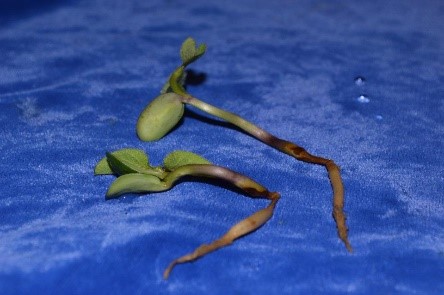The 2019 planting season has certainly been one of the most challenging in recent memory. Cool, wet conditions have delayed planting in most parts of the state. With beans finally going into the ground, growers may be interested in the disease outlook for this season. Dr. Teri Hughes, plant health scientist with Bayer Crop Science says that plants are like people when it comes to fighting off diseases. They are generally pretty good at resisting infection, but anything that stresses the plant increases the opportunity for disease to take off. Poor soil conditions at planting or unfavorable environmental conditions during the growing season can stress plants and encourage disease infection. Diseases to look out for include Pythium, Phytophthora, and Rhizoctonia.
Fusarium can also infect soybeans in waterlogged and chilly soils. Seedlings and young plants are at the highest risk for infection. Fusarium causes poor emergence, reduced emergence, damping off or stunted seedlings. The roots of young infected plants will exhibit brown discoloration. Fusarium can also show up later in the growing season, and more mature infected plants will have poorly developed, discolored roots and reduced nodulation.
Pythium and Fusarium are both fungal pathogens, and there are numerous species in these genera which infect soybeans. There are over 50 Pythium species which infect plants and 30+ Fusarium species. Since these pathogens are made up of so many species, no genetic resistance is available. These diseases are best controlled through quality seed treatments. However, seed treatments only protect the seedlings for around 30 days. In most years, this should be sufficient to protect plants while they are most vulnerable. However, in a year in which seedlings are slow to develop there may be greater than 30 days between planting and the V3 growth stage, creating a greater likelihood that these fungi will be of concern.
There are other diseases that infect soybeans early in their lifecycle. Phytophthora is the most economically important of these, annually accounting for around 50 million bushels of yield loss in the United States. Phytophthora damage to seedlings looks like other seedling diseases and generally occurs in poorly drained or low-lying areas of fields. In contrast to Pythium, Phytophthora prefers slightly warmer soils. Fungicidal seed treatments can be effective, but the best Phytophthora protection comes from a combination of seed treatments and genetic resistance.
If the weather turns warm and dry after planting, Rhizoctonia can be a concern. As planting continues to be delayed, this becomes more likely to pose a problem. Since it prefers dry soils, Rhizoctonia can also be more problematic in light and sandy soils. Symptoms of this disease include damping off, sunken red lesions on the hypocotyl, and stunted plants. The only effective way to combat Rhizoctonia is with a seed treatment that is effective against this pathogen.
If you encounter any of these diseases in your soybean fields this summer, you may have to make several management decisions. If the disease impact is early, replanting could be a possibility. Decide whether the existing stand is sufficient to produce optimal yield. A good rule of thumb is not to consider replanting unless the existing stand is less than 100,000 plants. If the infection is not severe enough to warrant replanting, an R3 fungicide application may protect a weakened field’s ability to produce an acceptable yield. In fields where irrigation is an option, drought stress should be avoided. Just as in humans, diseases in plants are inevitable, but how they are treated can be the difference between an acceptable outcome and an unacceptable one








Comments
Add new comment